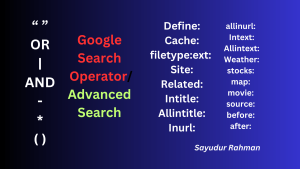Creating effective display ads, search ads, and video ads is crucial for a successful online advertising campaign. Each ad format serves a unique purpose and requires specific strategies to capture the audience’s attention and drive engagement. In this comprehensive guide, we’ll delve into the intricacies of creating compelling ads for display, search, and video platforms.
Google AdWords, now Google Ads, is a system for online advertising of products and services on Google. For such advertising, you need your online account and website to link. Sign up and creating an account with this system is free and easy, taking only couple of minutes

1. Display Ads: Capturing Attention Through Visual Appeal
Display ads are visually engaging advertisements that appear on websites and apps. These ads can include images, text, and interactive elements to attract users. To create effective display ads:
1. Define Your Objectives: Before diving into design, clarify your advertising goals. Are you aiming to drive traffic, increase brand awareness, or boost conversions? Understanding your objectives will shape your ad content and design choices.
2. Know Your Audience: Identify your target audience to tailor your display ads to their preferences and behaviors. Consider demographics, interests, and online behavior to create ads that resonate with your potential customers.
3. Choose the Right Platform: Select the platforms where you want your display ads to appear. Popular choices include Google Display Network, social media platforms, and industry-specific websites. Each platform may have different specifications, so be sure to adhere to their guidelines.
4. Design Eye-Catching Visuals: Visual appeal is crucial for display ads. Use high-quality images or graphics that align with your brand. Ensure that visuals are clear, relevant, and attention-grabbing, even at smaller sizes.
5. Craft Compelling Copy: Keep your copy concise and impactful. Highlight key benefits, use persuasive language, and include a clear call-to-action (CTA). Make sure your message is easily digestible, even during a brief glance.
6. Optimize for Responsive Design: Given the variety of devices and screen sizes, design ads that adapt to different platforms. Responsive design ensures your ads look good and function well on desktops, tablets, and mobile devices.
7. Utilize Animation Wisely: Animated elements can capture attention, but use them sparingly and purposefully. Excessive animation may distract or annoy users. Ensure that animated elements enhance the message rather than overshadow it.
8. Test Multiple Variations: Conduct A/B testing with different ad variations to determine which elements resonate best with your audience. Test different visuals, copy, CTAs, and even color schemes to optimize your display ads over time.
9. Implement Retargeting Strategies: Leverage retargeting to re-engage users who have previously visited your website. Show tailored ads to remind them of your products or services, encouraging them to return and complete a desired action.
10. Monitor Performance and Adjust: Regularly analyze the performance of your display ads using analytics tools. Track metrics such as click-through rates (CTR), conversions, and impressions. Use this data to refine your strategy and improve future ad campaigns.
11. Adhere to Design Best Practices: Follow design best practices, such as maintaining a clear hierarchy, using readable fonts, and incorporating your brand colors. Consistency in design across your ads helps reinforce brand recognition.
12. Stay Compliant with Ad Policies: Different advertising platforms have specific guidelines and policies. Ensure your display ads comply with these rules to avoid rejection and potential penalties.
Creating effective display ads requires a balance of creativity, data-driven decision-making, and a deep understanding of your target audience. By focusing on visual appeal, clear messaging, and strategic placement, you can maximize the impact of your display advertising campaigns.
Creating compelling search ads involves understanding your audience, conducting keyword research, and crafting concise and persuasive ad copy. Here’s a step-by-step guide on how to create effective search ads:
1. Define Your Goals: Clearly outline the objectives of your search ad campaign. Whether it’s driving website traffic, increasing sales, or promoting a specific offer, understanding your goals will shape your ad strategy.
2. Identify Your Target Keywords: Conduct thorough keyword research to identify the terms and phrases your target audience is likely to use when searching for products or services like yours. Use tools like Google Keyword Planner or other keyword research tools to build a comprehensive list.
3. Structure Your Campaign: Organize your campaign by creating ad groups based on themes or product categories. Group relevant keywords together to ensure that your ad copy is closely aligned with the user’s search intent.
4. Write Compelling Ad Copy: Craft concise and engaging ad copy that speaks directly to your audience. Use a clear headline, highlight key benefits or unique selling propositions (USPs), and include a strong call-to-action (CTA). Adhere to character limits to ensure your message is succinct.
5. Utilize Ad Extensions: Take advantage of ad extensions to provide additional information and encourage user engagement. Extensions like site link, callout, and structured snippet extensions can enhance your ad and provide more value to potential customers.
6. Incorporate Relevant Landing Pages: Ensure that your ads direct users to specific, relevant landing pages on your website. The landing page should align with the ad’s messaging and provide a seamless user experience. Optimize landing pages for conversions.
7. Set Bidding and Budgets: Determine your bidding strategy and set a budget for your campaign. Understand different bidding options, such as manual bidding or automated bidding strategies, and adjust your bids based on performance data.
8. Use Ad Schedule and Location Targeting: Tailor your ad schedule to coincide with peak times when your target audience is most active. Additionally, refine your targeting by selecting specific locations where your ads will be shown to reach your desired audience.
9. Implement Negative Keywords: Include negative keywords to filter out irrelevant searches and prevent your ads from appearing in unrelated queries. This helps improve the relevance of your ads and reduces unnecessary ad spend.
10. Monitor and Analyze Performance: Regularly review the performance of your search ads using analytics tools like Google Analytics or the ad platform’s built-in reporting. Monitor key metrics such as click-through rate (CTR), conversion rate, and return on ad spend (ROAS).
11. Optimize Based on Data: Use performance data to make informed optimizations. Adjust your keyword strategy, experiment with different ad variations, and refine targeting settings based on what works best for your campaign objectives.
12. Stay Informed About Changes: Stay updated on changes to search engine algorithms, ad formats, and best practices. Adapting to industry updates ensures that your search ads remain effective and compliant.
By combining strategic keyword targeting, compelling ad copy, and ongoing optimization, you can create search ads that effectively reach and resonate with your target audience, ultimately driving the desired actions on your website.
Video Ads: A video ad is a promotional message conveyed through a video format. It combines visuals, audio, and often text to engage and persuade viewers. Video ads are widely used across online platforms, social media, and television to showcase products, services, or brand messages in a dynamic and engaging way. They aim to capture the audience’s attention and deliver a compelling message within a short duration, fostering brand awareness, engagement, and conversions. Creating an effective video ad involves strategic storytelling, attention-grabbing visuals, and a clear call-to-action.
Creating a compelling video ad involves a thoughtful combination of planning, storytelling, and technical execution. Here’s a comprehensive guide on how to create an effective video ad:
1. Define Your Goals: Clearly outline the objectives of your video ad. Whether it’s increasing brand awareness, driving website visits, or promoting a specific product, having well-defined goals will guide your creative process.
2. Know Your Audience: Understand your target audience’s preferences, interests, and behavior. Tailor your video content to resonate with your audience and address their needs or pain points.
3. Craft a Strong Storyboard: Plan your video by creating a storyboard that outlines the sequence of scenes, visuals, and key messages. This helps maintain a cohesive narrative and ensures that your video effectively communicates your message.
4. Keep it Concise: Attention spans are limited, so aim for a video length that holds viewers’ interest. For online platforms, a typical video ad is often around 15-30 seconds. Deliver your message succinctly and make every second count.
5. Start with a Hook: Capture viewers’ attention in the first few seconds. An engaging hook encourages users to keep watching. This could be a visually striking image, a compelling question, or a statement that piques curiosity.
6. Tell a Compelling Story: Create a narrative that resonates with your audience. Address their pain points or aspirations, and showcase how your product or service provides a solution or adds value to their lives.
7. Focus on Visual Appeal: Invest in high-quality visuals. Use professional cinematography, appealing graphics, and animations. Ensure that your video is visually striking and aligns with your brand’s aesthetics.
8. Incorporate Branding: Integrate your brand elements seamlessly. Include your logo, brand colors, and any recognizable brand imagery. Consistent branding helps reinforce brand identity and improves recall.
9. Use Clear Calls-to-Action (CTA): Clearly communicate what action you want viewers to take after watching the video. Whether it’s visiting a website, making a purchase, or subscribing, a strong and concise CTA guides user behavior.
10. Optimize for Sound-Off Viewing: Many users watch videos with the sound off, especially on social media platforms. Ensure that your video’s message can be understood even without sound. Use subtitles or visual cues to convey important information.
11. Test and Iterate: Conduct A/B testing with different versions of your video ad to see what resonates best with your audience. Analyze performance metrics such as view-through rates, engagement, and conversion rates to refine your approach.
12. Choose the Right Platforms: Tailor your video ad format to the platform where it will be displayed. Different platforms have specific requirements and guidelines for video ads. Whether it’s YouTube, Facebook, Instagram, or other channels, adapt your video accordingly.
13. Ensure Mobile Compatibility: With a significant portion of video views occurring on mobile devices, optimize your video ad for mobile viewing. Consider vertical formats and ensure that your visuals and text are clear on smaller screens.
14. Monitor Analytics: Use analytics tools to track the performance of your video ad. Pay attention to metrics such as views, engagement, click-through rates, and conversions. Analyzing these data points helps you refine your strategy for future video campaigns.
Creating an effective video ad involves a combination of storytelling, visual appeal, and strategic planning. By understanding your audience, crafting a compelling narrative, and optimizing for various platforms, you can create video content that resonates with viewers and achieves your advertising goals. For more information click here.
Tips for Continuous Improvement in Ad Campaigns
* Monitor ad performance regularly and make data-driven optimizations.
* Stay updated on industry trends and consumer behavior to adapt your strategies.
* Test new creative approaches, targeting methods, and ad formats for continuous improvement
In conclusion, creating effective display ads, search ads, and video ads requires a combination of creativity, strategic planning, and continuous optimization. Understanding the unique characteristics of each ad format and tailoring your approach to the specific platform and audience are key elements of a successful online advertising strategy. By implementing these strategies, you can enhance your brand visibility, drive user engagement, and ultimately achieve your advertising goals.
FAQs on Creating Display Ads, Search Ads, and Video Ads
1. What are Display Ads?
Display ads are visual advertisements that appear on websites, apps, or social media platforms. They usually consist of images, text, and sometimes video elements. These ads are designed to attract the attention of potential customers and drive them to take a specific action, such as visiting a website or making a purchase.
2. How to Create Effective Search Ads?
To create effective search ads, it’s important to use relevant keywords that match what users are searching for. Craft compelling ad copy that highlights your unique selling points and includes a clear call to action. Test different variations of your ads to see which ones perform best and optimize based on the results.
3. What Should I Consider When Creating Video Ads?
When creating video ads, consider the platform where the ad will be displayed and tailor the content accordingly. Keep your message clear and concise, and make sure the video is visually engaging. Incorporate branding elements early in the video and include a strong call-to-action at the end to encourage viewers to take the desired action.
4. How to Optimize Display Ads for Better Performance?
To optimize display ads for better performance, consider targeting options such as demographics, interests, and behaviors to reach your target audience effectively. Use eye-catching visuals and compelling ad copy to grab users’ attention. Monitor the performance of your ads regularly and make adjustments based on the data to improve results.
5. What Metrics Should I Track for Ad Campaigns?
When running ad campaigns, it’s important to track key metrics such as click-through rate (CTR), conversion rate, cost per click (CPC), and return on ad spend (ROAS). These metrics can help you evaluate the effectiveness of your ads and make informed decisions on how to optimize your campaigns for better results.





